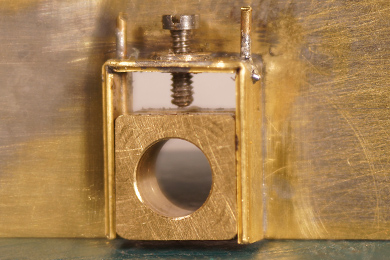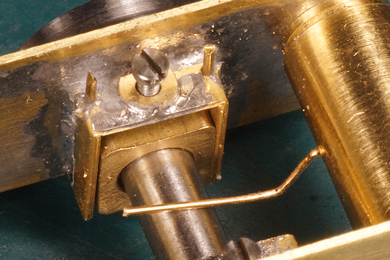Garrattfan's Modelrailroading Pages

LTM 51 in HO
Drive units - a trial with a sprung frame
An attempt at a sprung chassisThe frame plates as supplied have holes to accommodate fixed bearing bushes. This results in a three axle rigid frame setup. This works but it has been a long standing wish of mine to build a loco frame with sprung axles for better road behaviour and better electrical pickup. I wanted to experiment with this without possibly destroying the original so I made two identical frame plates from 0.4 mm (16 thou) brass based on the outline of the original ones.. |
|||||||||||||
These were the first objects I filed with my newly acquired Vallorbe 140-K2 needle files (24 July 2020) I bought these files on encouragement by a fellow builder and by ClickSpring's videos. I bought them from VoF van de Gevel in Tilburg, Netherlands, an excellent seller! And boy did these files work! These files are so straight and true you can make very dependable and predictable strokes. The two squares I filed in the two plates (then still soldered together to make them identical) measure 7.5 by 6.0 mm and all dimensions are within a 0.1 mm tolerance. The hole for the bush was first drilled undersize and then filed to a tight fit. And indeed the fit is so precise that the bush sits without falling out. |
|||||||||||||
 |
|||||||||||||
Next is mounting the sprung hornblocks. The springing does not work as per the prototype. The objective of sprung hornblocks on model locomotives are maintaining electrical contact and preventing derailments on uneven track.
So this works exactly opposite as a real locomotive's springing
Mounting the hornblocks is not overly difficult. I soldered the Alan Gibson sprung hornblocks in place as per the manual. |
|||||||||||||
 |
The only snag is the mounting of the tiny coil springs that are supposed to go on top of the hornblock and be held in place by the adjustment screw. One disappeared even before trying to mount it and the second escaped very soon after mounting. The spring does not sit very well on the top of the hornblocks. It slips easily and becomes trapped on the top of the hornblock in an awkward position. I found no way to make them sit securely. Their tendency to vanish is one reason why I dislike coil springs. A second reason is that they are not adjustable. So in the end I left them away altogether in favour of a springing of my own. | ||||||||||||
I drilled a 0.3 mm hole through the frame spacers in which I soldered a phosphor bronze spring which just touched on the middle of the axle when it is on its lowest position. Effectively I now have a four point suspension. |
|||||||||||||
 |
I have yet to clean up the soldering, which I will after I have decided that this is the way to go. For now the hornblock is functional. | ||||||||||||
 |
When completely depressed the sprung axles should all rest on the same height as the fixed middle axle. So I put the frame on a glass plate, to ensure 100% flatness of the underground, and set up my height gauge. First I measured the middle axle's height and next I adjusted the set screws of the other axles to achieve the correct settings.
Well, I guess that is well within tolerance. I may to do some more final adjustments in the right side |
||||||||||||
Finally I weighted down the frame to determine how much weight should rest on the drive unit to make it rest on its set screws. Initially this was a tad on the high side but after some adjustments of the phosphor bronze wires the total weight it needed was about 40 grams. As the boiler cradle in its current unfinished state already weighs 62 grams the pivot side of the drive unit will be loaded sufficiently to settle on its spring. The other side will need some 20 grams. This will be the combined weight of the motor and extra lead and I think I can achieve that. |
|||||||||||||
| So far I was very doubtful about a sprung chassis but now I have built one I am pretty happy with the results. Yet giving it careful consideration I found that the supposed advantages of the springing did not outweigh the added complexity of the build. I kind of chickened out. So in the end I decided to build two conventional rigid frames. | |||||||||||||






Sign my
GuestBook